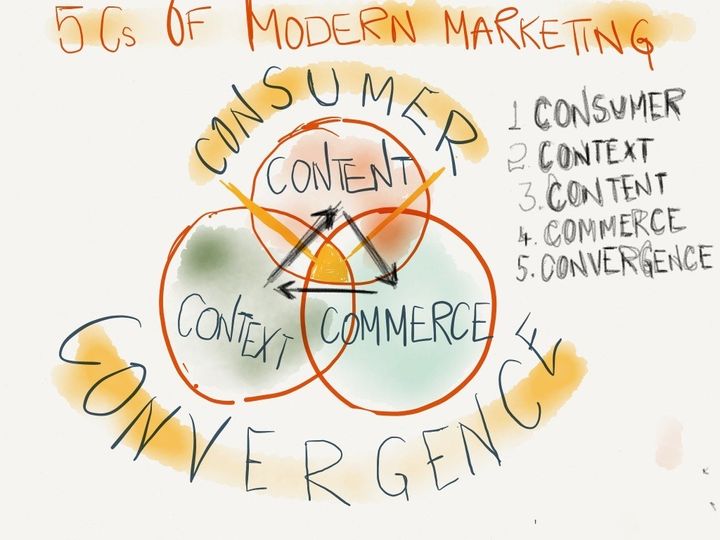“Context gives you the relevancy to earn the permission to potentially engage.” – Ray Wang
How do companies market in the age of the nearly always connected customer to achieve sustained breakthrough growth? To achieve relevance that can lead to sustained hyper growth, companies must be able to develop an always-on marketing engine. But it turns out that only 15% of businesses have advance sales and marketing talent, technology and processes need to deliver an always-on marketing experience, this according to the latest research by Harvard Business Review and Salesforce.
Mayur Gupta of Spotify defines an always-on marketing machine as “an organization that always listens to consumer behavior to capture signals from across all channels and touchpoints; translates them into insights and unmet needs at an individual level; and programmatically translates these unmet needs into contextual content delivered in an omni-channel world.” Gupta believes that a successful omni-channel strategy requires a continuous development of contextual intelligence built upon these four tenants:
- A holistic view of the consumer. Segmentation by channel creates multiple views of a single user.
- If content is king, context is God. Contextual intelligence improves the signal to noise ratio, and is the only way marketers can achieve relevance in an attention economy.
- Plan for omni-channel planning. Understanding your customer - at the functional and emotional level - across the channels of their choice can lead to strong engagement.
- Adopt a beginner’s mindset (curious, flexible, interested, adaptive) and apply a continuous experimental and iterative model based on a data-driven framework with a bias towards results
To better understand the current marketing technology landscape, specifically focusing on the user of artificial intelligence to improve mass contextual and personalization at scale, Ray Wang and I invited Mayur Gupta to DisrupTV – our weekly show covering business, innovation and leadership disruption.

Mayur Gupta, Vice President of Growth and Marketing at Spotify
Mayur Gupta is the global vice president for growth and marketing at Spotify. He is responsible for driving growth for Spotify across MAU, DAU and paid subscriptions by leveraging data driven always-on experiences; testing new business models, partnerships and engagement strategies along with establishing marketing capabilities for fans, artists and B2B brand partners. Prior to Spotify, Gupta led marketing at Healthgrades and he was the first ever Chief Marketing Technologist at Kimberly Clark, responsible for the vision, strategy and development of all digital and e-commerce capabilities. Harvard Business Review, Economist, Forbes, Huffington Post and AdAge profiled him as the model Chief Marketing Technologist. Gupta is a keynote speaker and a highly influential thought leader on social media. Gupta is also one of the top marketing technologists on Twitter: @inspiremartech
The last time Gupta and I collaborated on the topic of modern marketing, we discussed the C’s of digital marketing: consumer, context, content, commerce, convergence, and communities.

The Cs of Modern Marketing - Mayur Gupta
We asked Gupta to further elaborate on systems thinking, precision marketing and growth.
How do you drive breakthrough business growth? According to Gupta, breakthrough growth is driven through intrinsically cross-functional collaboration across product, market and content and when you apply this intersection throughout the journey you identify high quality and high value users that can accelerate growth. This is not just about numbers. The mis-management of the journey -- acquisition, engagement, to reactivation – can cause businesses to bleed twice; you bleed in paying a lot more to obtain a low value user and then pay again trying to retain somebody who doesn’t want to a user. Growth is not an outcome. Growth is about input. Growth is an output of doing a lot of things right.
What is the biggest change in marketing today? Gupta notes that marketing is starting to play a more tangible role as a key contributor of driving business growth. It starts with understanding users as humans, better understanding of their needs – both functional and emotional – and then tailoring the marketing messaging in an always-on model to drive and meet the ever changing and growing user expectations.
How to achieve sustainable, breakthrough growth? To drive sustainable and breakthrough growth requires a fundamental organizational shift, where no single unit owns the responsibility of growth. This requires systems thinking approach of delivering value to end-users. The use of data to gain user insights and what Gupta calls ‘contextual intelligence at scale’ is what businesses need to develop to produce breakthrough growth.
How to you develop a systems thinking approach? According to Gupta, central to successful digital transformation in marketing is systems thinking. Gupta advises organizations to focus on four key elements of systems thinking:
- Elevate your customer understanding efforts.
- Establish a common “north star.”
- Integrate your ecosystem planning to break down silos.
- Reinforce and reward behaviors consistent with the ecosystem view.
What is the importance of contextual intelligence in marketing as a growth driver? The fundamental challenge that marketers face is that we speak about putting the ‘customer at the center’ but the reality is that marketers put ‘channels at the center’. The structure of marketing, how we organize, partner, incentivize and invest is all around channel. Gupta notes that we buy media by channel, agency partnerships by channel, structure teams and promote using channels.
“The entire notion of always-on is really about customer relationship management done right,” said Gupta. The contextual understanding of your users – emotionally and functionally – and then delivering the right value, across the right channel, at the right time, to the right user, is doing CRM right. CRM is not a channel. CRM connects to everything. That’s how companies can earn the right to customer loyalty and advocacy.
How can marketers manage their work manually without the use of AI and automation? Gupta said that most companies are not even doing effective marketing manually – even some manual work would be consider innovative. A single view of the consumer is key to success. Marketers who use DMP as one example of data mastering and matching can gain relevance by graduating from channel segmentation to a longitudinal view of gleaning user related insights. It’s okay to try to do this manually. Start by applying small scale manual practices, do it well, and then apply artificial intelligence and machine learning to accelerate the discovery, prediction, recommendation and automation at scale capabilities. Success requires data, algorithms and automated work-flows combined that can deliver augmented intelligence in marketing.
What limits business growth? The fundamental roadblock to growth is the underlining organizational silos that exist in a business, caused by the complexity that is inherently a part of existing business models and organizational structures. The desperate set of functions, laid across multiple lines-of-business, create a fragmented and broken experience for customers and end-users. Systems thinking and design thinking can help eliminate and simplify heavy processes and organizational silos that prevent companies to see their blindspots as it relates to recognizing, measuring and continuously improving the customer experience.
I encourage you to watch the brilliant video conversation with Mayur Gupta. Gupta provides rich examples of how companies can achieve sustained hyper growth by lean into emerging marketing technologies, while designing a systems approach toward really putting the ‘customer at the center’ while designing and delivering your products and services.
